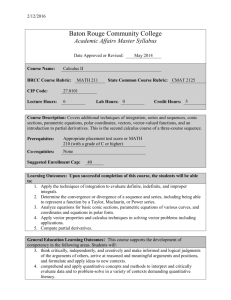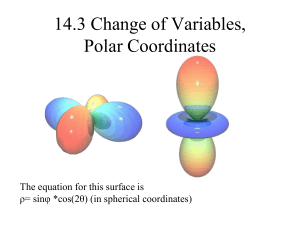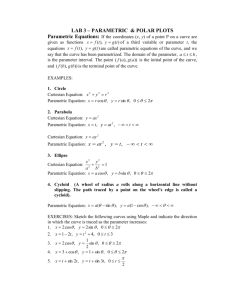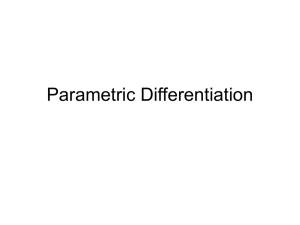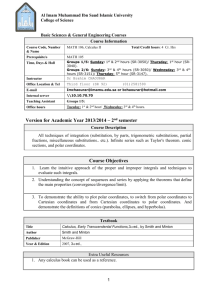10 Parametric Equations and Polar Coordinates.
advertisement
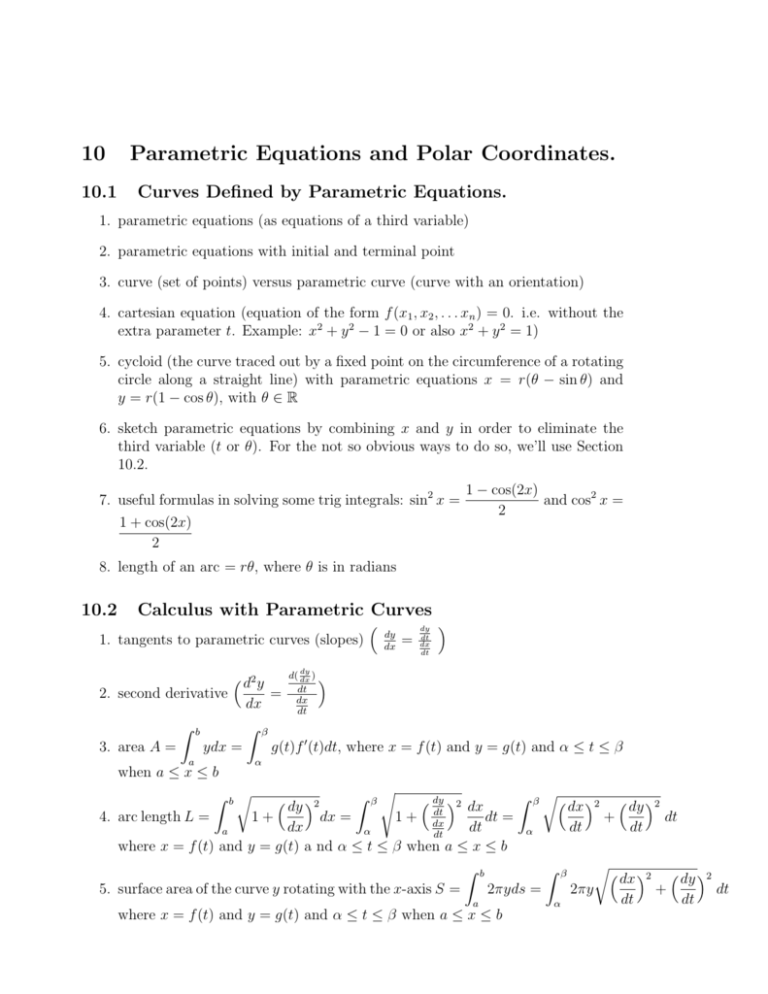
10 10.1 Parametric Equations and Polar Coordinates. Curves Defined by Parametric Equations. 1. parametric equations (as equations of a third variable) 2. parametric equations with initial and terminal point 3. curve (set of points) versus parametric curve (curve with an orientation) 4. cartesian equation (equation of the form f (x1 , x2 , . . . xn ) = 0. i.e. without the extra parameter t. Example: x2 + y 2 − 1 = 0 or also x2 + y 2 = 1) 5. cycloid (the curve traced out by a fixed point on the circumference of a rotating circle along a straight line) with parametric equations x = r(θ − sin θ) and y = r(1 − cos θ), with θ ∈ R 6. sketch parametric equations by combining x and y in order to eliminate the third variable (t or θ). For the not so obvious ways to do so, we’ll use Section 10.2. 7. useful formulas in solving some trig integrals: sin2 x = 1 + cos(2x) 2 1 − cos(2x) and cos2 x = 2 8. length of an arc = rθ, where θ is in radians 10.2 Calculus with Parametric Curves 1. tangents to parametric curves (slopes) 2. second derivative Z 3. area A = d2 y b dx Z a dy dx = dy dt dx dt β ydx = when a ≤ x ≤ b = dy ) d( dx dt dx dt g(t)f 0 (t)dt, where x = f (t) and y = g(t) and α ≤ t ≤ β α Z βs Z br Z β r 2 2 dy 2 dy 2 dx dx dy dt dx = + dt 4. arc length L = 1+ 1 + dx dt = dx dt dt dt a α α dt where x = f (t) and y = g(t) a nd α ≤ t ≤ β when a ≤ x ≤ b r Z b Z β dx 2 dy 2 5. surface area of the curve y rotating with the x-axis S = 2πyds = 2πy + dt dt dt a α where x = f (t) and y = g(t) and α ≤ t ≤ β when a ≤ x ≤ b 10.3 Polar Coordinates 1. cartesian coordinates (x and y values of a point in the x − y plane) 2. polar coordinates (polar system has a pole (the origin) and a polar axis (the positive x-axis). And so the polar coordinates of P are r = the distance(O, P ), and θ = the angle, in radians, that OP maxes with the polar axis) 3. cartesian coordinates in terms of polar coordinates: x = r cos θ, y = r sin θ p y 4. polar coordinates in terms of cartesian coordinates: r = x2 + y 2 , tan θ = x 5. the graph of a polar equations r = f (θ) or F (r, θ) = 0 consists of the points that have polar coordinates r, θ 6. when sketching the curve r = f (θ), first draw the graph of f (θ) and use it to get the curve. 7. polar equation unchanged when θ is replaced by −θ, then curve is symmetric with the polar axis 8. polar equation unchanged when r is replaced by −r or when θ is replaced by θ + π, then curve is symmetric about the pole (i.e. the curve is the same if it is rotated 1800 ) 9. polar equation unchanged when θ is replaced by π − θ, then curve is symmetric about the vertical line θ = π2 dy 10. the tangent to the polar curve r = f (θ) is = dx dy dθ dx dθ == dr dθ dr dθ sin θ + r cos θ cos θ − r sin θ 10.4 Conic Sections. 1. conics = set of points that result from intersecting a cone with a plane: parabolas, ellipses, hyperbolas 2. an equation of the parabola with focus (0, p) and directrix y = −p (focus = fixed point, and directrix = a fixed line) is x2 = 4py (or y 2 = 4px if the focus is (p, 0) and the directrix x = −p) 3. an equation of the ellipse with foci (±c, 0) (where c2 = a2 − b2 , a ≥ b > 0) and vertices (±a, 0) is x2 y 2 + 2 =1 a2 b 4. an equation of the hyperbola with focii (±c, 0) ((where c2 = a2 + b2 ), vertices is (±a, 0), and asymptotes y = ± bx a x2 y 2 − 2 =1 a2 b 5. an equation of the hyperbola with focii (0, ±c) ((where c2 = a2 + b2 ), vertices is (0, ±a), and asymptotes y = ± ax b y 2 x2 − 2 =1 a2 b

